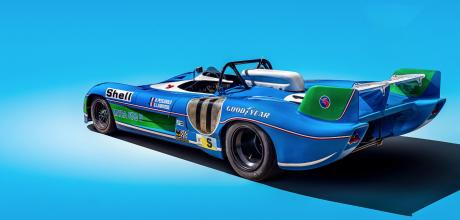1972 Matra-Simca MS670
How a French car won Le Mans for the first time since 1950, helped by Graham Hill.
ITʼS COMING HOME
If you’re a conspiracy theorist, the story goes like this: it’s 1971, and the Commission Sportive Internationale, motorsport’s Paris-based governing body, decides it’s been too long since a home-grown French team won Le Mans. National pride had been dented by the dominance of the Americans (Ford) and Germans (Porsche), so the CSI comes up with a cunning plan: it bans 5.0-litre engines and limits capacity to just 3.0 litres. None of the rival factory teams have a suitable engine ready for 1972… but a French manufacturer does!

Matra, recent winner of the F1 title with Ken Tyrrell and Jackie Stewart, has a 3.0-litre V12 that has been running at Le Mans since 1968! And so, in 1972, the French fairytale comes true – Ferrari and Porsche withdraw, and a Gallic Blue Matra MS670 wins the race to the delight of the partisan crowds! So the story goes, if you’re a conspiracy theorist… And if you’re not? Well, then it’s all a load of codswallop.
In reality, the CSI did reduce engine size to 3.0 litres for 1972, and this did hit Porsche and Ferrari; but the change was driven by a desire to align sports cars with F1 to benefit from the proliferation of 3.0-litre engines in the top-tier single-seater category. And while it’s also true that Ferrari didn’t contest the 1972 Le Mans because it knew its F1-derived V12 wouldn’t last the distance, the Italians won every other round that season – 10 out of 11 races – with its 312PB. So its 3.0-litre engine wasn’t too shabby.
No, Matra’s 1972 win came because the French team threw the kitchen sink at Le Mans. In 1972, Matra took four cars and over 120 engineers to the event, and its MS670 was built on six years of hard Le Mans graft. The team was also deeply patriotic and passionate. Four-time Le Mans winner Henri Pescarolo recalled years later: ‘We were ready to kill ourselves for the team.’
The desire for some true-blue French success didn’t get in the way of driver selection, however. In 1972 Pescarolo found himself sharing the MS670 with double F1 champion Graham Hill, a decision the Frenchman resisted at first. ‘Le Mans is so different from F1. I said “What if it’s raining in the night, or there’s fog in the morning, do you think he will be prepared to take risks?”’
However, in a race dogged by bad weather, Pescarolo saw Hill’s class. ‘He was bloody quick, of course,’ the Frenchman said. ‘When I looked at his lap times during the night, and in the rain, I thought, “Okay, I can sleep now.”’
And so the pair won the 1972 race in a triumphant Matra 1-2, making Graham Hill the first and so far only driver to win motorsport’s “Triple Crown”, with victories in Monaco, the Indy 500 and Le Mans.
It also made this Matra MS670 a very special car. When it came up for sale recently, Pescarolo was horrified, describing it as ‘a monument of world and French motorsport’ that needed protecting. That didn’t stop it selling for over £6 million – a price that reflected both its significance, and the allure of that screaming 3.0-litre V12.
TECHNICAL DATA 1972 MATRA-SIMCA MS670B
- ENGINE 3.0-litre V12
- MAX POWER 450bhp
- MAX TORQUE 299lb ft
- TRANSMISSION Five-speed manual
- LAYOUT Mid-engined, rear-wheel drive
- CONSTRUCTION Aluminium monocoque with open-cockpit fibreglass body
- WEIGHT 678kg
- LAP TIME 3min 39sec (outright fastest in 1973 race)
Simca left the car world in 1978, then Matra in 2003 Rules still demanded cockpit room for two
1970S: POWER TO THE PEOPLE
Le Mans in the 1970s belonged to Porsche, which took its first outright Le Mans win in 1970. The legendary 917 (below) won again in 1971, before a change to the engine rules saw the flat-12 banned for 1972. However, Porsche came back with its 936 to win twice more in 1976 and 1977, and then – remarkably – in the 1979 race, when the factory prototypes retired and it was a 911-based Porsche 935 that took the chequered flag, one of those once-in-a-generation upsets that Le Mans is so good at.
But the decade was also about privateers. The 3.0-litre engine rule, introduced in 1972, brought F1’s ubiquitous Ford Cosworth DFV engine into endurance racing, and it livened up the Le Mans grids just as it had in Formula 1. Tiny outfits like de Cadenet and Rondeau were made competitive by this off-the-shelf ‘crate’ engine, and in 1975 DFV engines finished 1-2-3, with the Gulf-sponsored Mirage-Cosworth winning the race.


